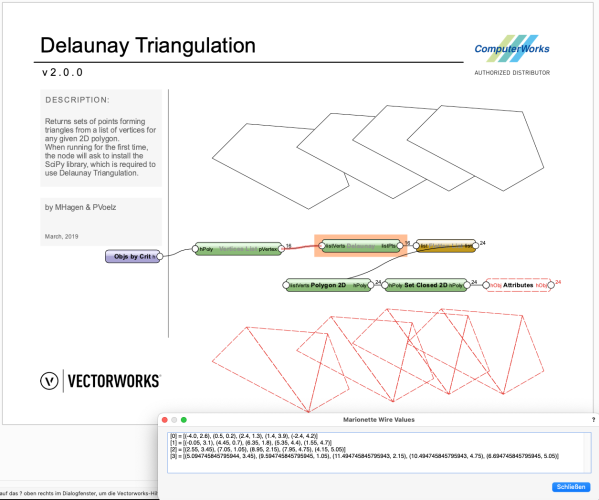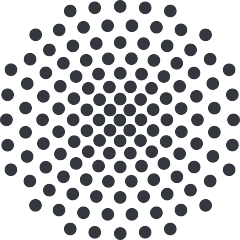
Antonio Landsberger
-
Posts
211 -
Joined
-
Last visited
Content Type
Profiles
Forums
Events
Articles
Marionette
Store
Posts posted by Antonio Landsberger
-
-
Hi Krovex,
no. 🙂 It should be possible to get and show the names of all selected symbols from the currently active layer.
...
I just made a short test and for some reason the filter doesn't seem to work.
I simplified the first wrapper a bit.
-
KroVex,
this behaviour is WAD. Unfortunately there is no criterion "active layer".
So, if you want to filter for certain layers (active layer for example), you have to use the equal and filter nodes to only get the items from that layer. -
This might be a bug with the (Move or Rotate Node in a) Marionette Object. The wrapped network still works as expected, but the Marionette Object suddenly lays down flat the profile used for a path extrude. The issue persists with VW29.0.5b(748294).
-
If you use Vectorworks 2023 or 2024, you can save your Marionette Objects (I assume that that is what you mean by "Plug-In Objects") as a style and thus when you change the network (or code) in one instance of this style, you change it in all instances.
If that doesn't work for you, could you please upload a simple version of what you are trying to accomplish?
-
On 3/14/2024 at 2:42 PM, tavbut said:
I could do that using the Objects by Criteria node and selecting each layer individually, but I wonder if there is a way to call for a set of layers by any common parameter like tag, story, or the first letter layer's name.
The criteria dialog (from Objs by Crit) does not support these properties as far as I know. Not even the last of your wishes: "the first letter layer's name". And I quote: "the current listbrowser class control on the criteria dialog doesn't support both picking class [or layer] names and typing a prefix into an edittext".
But you should be able to query every item, and sort them out depending on the result using the filter node. To do that you would most likely have to start making custom nodes, because these probably don't exist, yet.
-
On 3/5/2024 at 12:10 PM, Stefan B. said:
Scaffolding parts have a record name "Scaffold Record" attached, while I'm able to attach this record to the symbols I insert, I cannot see the record at any point.
Attaching the record formats to the symbols inside the Marionette Object will make it impossible to see in the OIP, unless you create a new record format that is only attached to the Marionette Object (see Marissa's reply) and shows the values from the fields of the record formats attached to the symbols, but also writes back changes you made in the OIP.
An alternative could be to use a worksheet to read and write these otherwise hidden record formats.
-
Hi @mlohse
Welcome to the Vectorworks forums and the Marionette discussion in particular.
In such cases I found it's best to first do the steps manually and see what the required tools/objects or menu items are, to get to the result you want and then go backward through these steps and see, if there are Marionette Nodes with these names. If you are missing an object (unlikely) or a menu item (likely) you might need to make a custom node yourself or ask, if someone here can help you out.
If you want to try this on your own, you should follow the link to the dev wiki pinned in all Customization discussions at the top of the page.
From there you can use the search to find VectorScript commands you might need for your custom Marionette Node.
When dealing with menu items, a good starting point is the command DoMenuTextByName:
https://developer.vectorworks.net/index.php?title=VS:DoMenuTextByNameGood luck!
-
 1
1
-
-
Welcome to the international Vectorworks forum!
Please try this node here and let me know if this works for you. If not please provide a test file here or message me the file.
-
Hi @HebHeb,
this should really be trivial.
Have you tried the Delaunay triangulation node here?
I'm attaching an new yet unofficial version as a Vectorworks 2023 version here:
Delaunay-Triangulation-v2.0.0.v2023-refresh.vwx
-
 1
1
-
-
On 1/25/2024 at 4:23 PM, Kokhoveniers said:
Hi @Letti R, I dont think you get 3D tiles from this right?
No, this version only supports 2D tiles. A future version might support 3D tiles, but currently there is no plan to update this Marionette tool.
-
On 11/7/2023 at 3:31 PM, KingChaos said:
hi,
i am trying to manipulate this
node. I need an input port (for my Layer name), which is the criteria in the filter.
therefore it would be the best i can use this node
, BUT its output port should not get the handle of the layer. it must output the "name" of the layer to let this get into the "objs by crit"
node.
i need a popup-driven "objs by crit" node 🙂
Can someone do this for me or help me with it?
BR KC
Hast Du Dir das hier schon angeschaut?
https://www.vectorworksforum.eu/topic/22032-marionette-obj-by-crit/#comment-96204
-
Hi folks ( @DomC@AlanW@Olaf Pfeifer ),
Late 2021 I got a developer to add two new VectorScript commands for the use of record popup fields:
PopupGetChoices and PopupSetChoices
Good luck!
Antonio
-
 1
1
-
-
It's not a simple problem to solve I'm afraid - if you depend on the regular Marionette Nodes that is.
I tried my hand, but it's getting quite convoluted and compared to this one here it might not even be possible to solve with the default Node library.
If I had to do this, I would most likely write my own node.
Maybe @DomC or @Letti R know how to tame this network to do their bidding.
@Marissa Farrell This network would also benefit from a modified Chunk Node that can take a list instead of a single integer.
-
 1
1
-
-
Hi @ASag,
First off: your example file only contains what is visible in the screenshot you posted: text and rectangle objects. Unless it's well hidden, there are no Marionette Nodes in there.
Then: please have a look at this wonderful Marionette tool by @DomC:
This might be all you need, because this looks pretty similar.
From the partial screenshot of the network I cannot tell what you are trying to accomplish. Could you maybe post a document with the network?
-
@Niels Timmer and @HebHeb
Please send your findings to your local distributor, so they can file a proper bug report.
-
 1
1
-
-
That sounds just like what is needed.
Thank you!
-
Let's say we have (styled) walls with symbols, (styled) doors and (styled) windows.
A script could go through all walls, but then what?
There is GetNumOfWallBreaks, but this will only give me an integer.
There is GetObjExtentsInWall, but this requires the SymbolH additionaly to the WallH. Also I would probably get FALSE for round walls as the boolean, not just for all the checks with all the different symbols etc.
Isn't there an easier and cleaner way of doing that?
The goal is to have a worksheet reporting primarily on windows and show in which wall style the window is placed in one of the columns. That can only happen, if the windows have this information (in a record format for example). A script could be a way to read out and write this information into the record format attached to the windows.
-
I know an easy way to do this:
Since Vectorworks 2022 you can use worksheet functions within the data tag. In this case I would go with the function IFS, because you have a fix amount of possible conditions paired with their output.
It would go like this:
#WS_IFS(('Lighting Device'.'Pan'>=-45)&('Lighting Device'.'Pan'<45),'↑',('Lighting Device'.'Pan'>=45)&('Lighting Device'.'Pan'<135),'←',('Lighting Device'.'Pan'>=135)&('Lighting Device'.'Pan'<225),'↓',('Lighting Device'.'Pan'>=225)&('Lighting Device'.'Pan'<=315),'→')#
It's always good practice to write the worksheet formula into an actual worksheet first. Once you are happy, you can insert it with this modification #WS_<># into the data tag formula field.
I used the first of the available arrow symbols for each direction from here:
https://symbl.cc/en/collections/arrow-symbols/-
 2
2
-
-
Hi @MrPilot,
QuoteThe code behind this node is buggy
Ok, which node is buggy? This topic is about different OIP controls and some custom nodes.
How is the node buggy? What is happening with which steps and what would be the expected behaviour instead?
In which Vectorworks version is it buggy?
Do you have a document, with which this bug can be seen?
Have you contacted your local distributor about this?
-
-
 2
2
-
-
I wanted to use the number in a text object. But we found a different approach, that doesn't require scripts.
-
Is there any way to read out the order number for design layers as can be seen in the navigation palette or the organization dialog?
I looked through the dev wiki, but couldn't find any VS command.
-
Perhaps this node could be improved by introducing an OIP option that can be toggled (preferably two radio buttons) that lets the user choose which behaviour they wish for.
-
 1
1
-
-
Could you please define what
VCS sync, LAN sync, and delta syncare and how they are different?
How do these work?





Objs by Crit -> VSEL not working in Menu Command
in Marionette
Posted
I won't be able to look at this any further until the end of next week unfortunately.